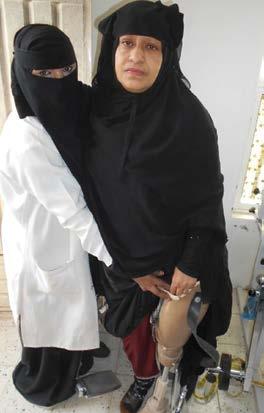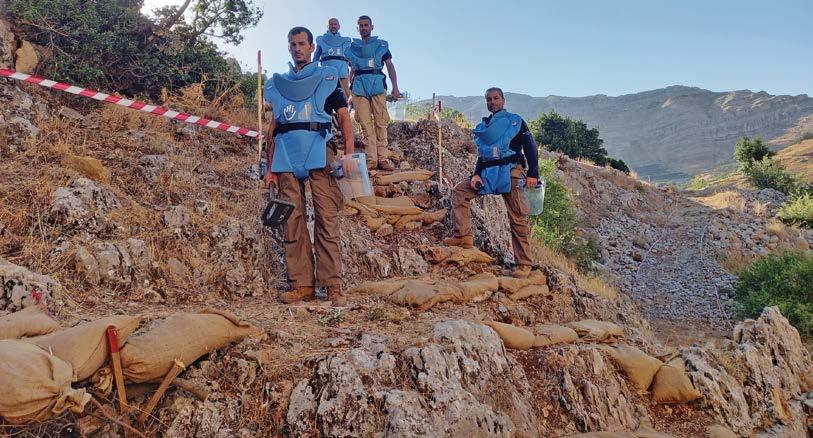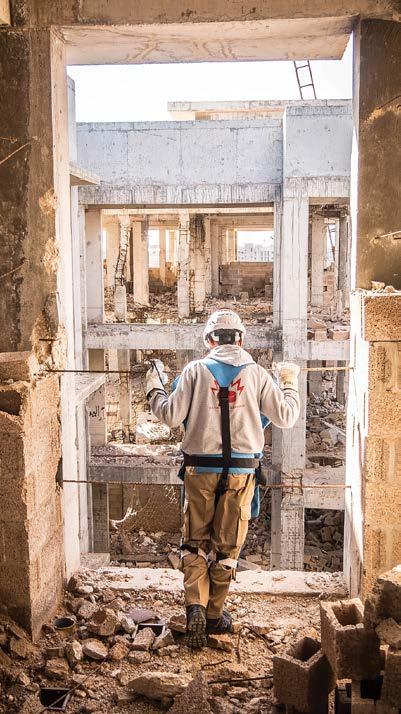
14 minute read
MIDDLE EAST AND NORTH AFRICA
TOTAL U.S. CONVENTIONAL WEAPONS DESTRUCTION FUNDING IN THE MIDDLE EAST AND NORTH AFRICA FROM ALL U.S. AGENCIES, 1993–2020: MORE THAN $904 MILLION
United States CWD programs are designed to enhance stability and improve human security in the Middle East and North Africa. In Iraq, Lebanon, Libya, and Syria, ISIS emplaced IEDs and landmines still threaten returning populations, impede stabilization, and block economic development. In Libya, illicit trafficking of SA/LW fuels both domestic and regional violence, imperiling U.S. national security interests and continuing to fuel displacement. In Yemen, significant quantities of UXO and the massive use of landmines and IEDs continues to kill civilians and block the delivery of urgent humanitarian assistance.
Advertisement
Of the 10 countries worldwide with the highest number of casualties from landmines and ERW in 2019, three—Iraq, Syria, and Yemen—are in the Middle East, according to the 2020 Landmine and Cluster Munition Monitor. This was due in large part to the ongoing conflicts in these countries.
Since 1993, the United States has invested more than $904 million in CWD to support regional stability in the Middle East and North Africa. U.S.-funded survey, marking, and clearance operations enable the safe return of displaced families to their communities, economic development, and the restoration of basic services as well as development of strong and capable host country CWD capacities. EORE reduces deaths and injuries, and survivor assistance projects provide rehabilitation and reintegration support. All these programs help lay the groundwork for stability and prosperity across the region.
ASMA, LATEFA, AND THE YEMEN ASSOCIATION FOR LANDMINE SURVIVORS (YALS)
Asma is a 50-year-old woman who lives with her family of nine in Taiz, Yemen. When she was 30 years old Asma was injured by a landmine explosion and lost her leg. She feared her dreams of helping her sons and daughters complete their education and achieving things in life had been denied.
“While my friends and I were working to bring firewood from the mountain, the mine exploded and my leg was injured. One of my friends told my family. They came and took me to the village hospital. Then, I was transferred to Al-Thawrah hospital and there my leg was amputated. When I woke up after the operation, and learned that I lost my leg, I felt sad for my injury, because I would not be able to work at home as I had before.

Asma is fitted for a prosthetic leg.
Latefa lives with her family of seven in Al Qaherah, Yemen. She lived a difficult life working as a teacher to help provide for her family despite the low, and sometimes non-existent salary.
“One day, I went to school as usual to teach the kids, and because I left late in the day to go home, I decided to walk in another way that was faster. I did not know that it was dangerous. The mine exploded and the passersby told my husband that I was injured. When the mine exploded and I saw myself bleeding badly I knew that I would not be able to teach the children again. When I got out of the surgery and saw that I had lost my leg, my dreams were lost and life became dark for me. I was thinking of a future that awaited my family and children with a disabled mother. I thought about our difficult living conditions that required me to work for my family and I thought of the children who waited daily for me to teach them and who tomorrow would not see me.”
Photo and story courtesy of YALS, supported by the Marshall Legacy Institute.

ERW and IED clearance is conducted between Mosul and Erbil, Iraq.
Photo courtesy of FSD.
IRAQ
ISIS seeded large swaths of Iraq with an unprecedented level of mass-produced, technologically sophisticated IEDs and other explosive hazards with the deliberate intent of harming civilians, discouraging the return of IDPs, and hindering stabilization efforts. Significant progress clearing ISIS IEDs has been made since 2015, but much work remains. The United States remains dedicated to supporting the survey and clearance of these explosive hazards from areas that remain heavily impacted as well as delivering EORE to those communities, including the ancestral homelands of Iraq’s ethnic and religious minority communities in Ninewa Province. Clearance of liberated areas remains a U.S. priority, as we continue long-standing support for the survey and clearance of legacy contamination in northern and southern Iraq, along with capacity building assistance for Iraq’s Directorate of Mine Action (DMA) and the Iraqi Kurdistan Mine Action Authority.
From 2003 to 2020, the United States invested more than $594 million to support the operations of more than 100 survey, clearance, and EORE teams across Iraq, as well as munitions destruction, and remains the largest international supporter of HMA activities there.
In 2020, the Department of State supported the following implementing partners:
• DDG cleared more than 2,250 explosive hazards in southern Iraq, including U.S.-origin ERW. They assisted in developing the program capacity of the Regional Mine Action CenterSouth (RMAC-S) in coordination with DMA and delivered EORE to more than 5,000 men, women, and children in southern Iraq.
• FSD cleared approximately 1,500 IEDs and ERW in towns liberated from ISIS between Mosul and Erbil, including areas historically inhabited by Christian, Yezidi, Shabak, Kaka’i, and Turkmen minority communities, thereby increasing civilian security, facilitating the return of IDPs, and enabling the safe resumption of farming and animal husbandry. FSD also established a Facebook EORE campaign that reached close to 231,000 individuals from May-December 2020.
• HALO began conducting survey and clearance operations in support of stabilization efforts in the Salah Al-Din Governorate, clearing approximately 400 explosive hazards and over 59,000 square meters (14.6 acres) of land.
• iMMAP continued to provide operational information management assistance and strategic planning capacity building support to Iraqi NMAAs. They also helped coordinate demining efforts between Iraqi authorities and organizations conducting demining operations in support of broader stabilization efforts, and served as third-party monitors for U.S.funded demining projects.
• MAG cleared more than 4,200 explosive hazards in Iraqi Kurdistan and areas liberated from ISIS in the Ninewa Plains and Sinjar, increasing security and allowing IDPs, including those from predominantly Christian, Shabak, and Yezidi villages, to safely return home and begin rebuilding their lives. MAG also provided EORE to over 6,000 individuals to increase the safety of civilians living in areas impacted by ISIS and legacy contamination.
• NPA cleared over 4,400 explosive hazards in southern Iraq and approximately 3,200 explosive hazards in Anbar Province. NPA continued to provide technical advisors to strengthen the ability of Iraq’s RMAC-S in its role as the regulatory body for coordinating and monitoring mine action activities in southern Iraq.
• SoS held soccer workshops across Iraq and adapted online programming that provided more than 20,000 children education and outreach about ERW risks, trauma resilience training for those affected by ISIS-related violence, and a meaningful alternative to joining extremist groups and participating in at-risk behavior.
• In coordination with Iraqi officials at the local, governorate, and national level, UN agencies, and other stakeholders, Tetra Tech surveyed, marked, and cleared 485 explosive hazards from Ninewa and 336 explosive hazards across Anbar, while delivering a combined total of 862 EORE sessions.
With funding from the Department of Defense HD R&D program, MAG cleared 2,234 mines and UXO from over 284,000 cubic meters (10 million cubic feet) of soil to date, using a Rebel contaminated soil processing plant, several excavator sifting attachments, a stand-alone orbital sifter, and multiple commercial front-loader attachments. Due to the terrain of clearance locations, the equipment was maintained but not used by MAG in 2020.
JORDAN
Although Jordan declared itself mine free in 2012 and made significant progress in reducing the threat of landmines and ERW from the 1948 conflict following the partition of Palestine, the 1967–1969 Arab-Israeli conflict, and the 1970 civil war, residual contamination remains along its northern border and in the Jordan River Valley.
From 1996 to 2020, the United States invested more than $29 million in CWD programs in Jordan, to include clearance of mines and ERW, delivery of EORE, rehabilitation and reintegration support for survivors of landmine and UXO accidents, and destruction of aging and obsolete munitions.
In 2020, the Department of State supported the following implementing partner:
• Polus continued to provide rehabilitative care, vocational training, and prosthetics support to Jordanians and Syrian refugees who are survivors of mine and UXO accidents due to ISIS-placed IEDs and other ERW.

A manual clearance team pauses work in Batroun District, Lebanon.
Photo courtesy of HI.
LEBANON
PSSM programs in Lebanon provided crucial support in 2020 as U.S.-funded upgrades to the Lebanese Armed Forces’ (LAF) First Artillery Regiment ammunition depot—located at the Port of Beirut—helped prevent further destruction after the August 4 explosion at the port. Lebanon remains contaminated with mines and ERW from the 1975–1990 civil war, the laying of minefields along the Blue Line between 1984–2000, the Israel-Hizballah conflict of 2006, and in northeastern Lebanon, where ISIS and other extremist groups more recently seeded fertile land with landmines and IEDs. As of late 2020, over 35 million square meters (8,649 acres) of land remained contaminated with explosive hazards according to the Lebanon Mine Action Center (LMAC).
From 1998 to 2020, the United States invested more than $82 million to support landmine and ERW survey and clearance, mine detection dog procurement and training, EORE, capacity building for the LMAC, and medical assistance and vocational training for landmine survivors, making the U.S. the largest international donor in Lebanon for these activities. U.S. assistance has also strengthened the LAF’s PSSM capacity.
In 2020, the Department of State supported the following implementing partners:
• MAG continued its PSSM capacity building engagement with the LAF, providing structural upgrades to ammunition depots, emergency repairs to the First Artillery Regiment depot in the wake of the Port of Beirut explosion, and assessing other LAF sites for possible future assistance. MAG continued to conduct ERW survey and clearance in South Lebanon, Nabatieh, and Arsal, clearing nearly 3,000 landmines, IEDs, and pieces of UXO. Operations in Nabatieh and South Lebanon facilitated access to fertile land that local communities can now use for raising livestock and agricultural development. In Arsal, MAG’s survey and clearance operations allowed local communities to safely plant and harvest cherry trees.
• DCA cleared over 360 explosive hazards from the Israeli–Lebanese conflict and the 1975–1990 civil war in Mount Lebanon governorate. This crucial program will facilitate the economic development of mine-impacted communities in the Aley and Baabda districts.
• HI continued to conduct ERW survey and clearance in northern Lebanon, clearing 37 landmines and other explosive hazards from the 1975–1990 civil war in and around Lebanon’s famed cedar forests. This life-saving work will allow local communities to use this land as well as enable visitors from Lebanon and beyond to visit surrounding recreational areas safely.
With funding from the Department of Defense HD R&D program, MAG continued to evaluate the Terrapin small remote excavator and several soil excavation, sifting, and grinding attachments mounted on armored excavators. Since 2011, HD R&D technologies have been used to clear 7,844 mines and UXO from 241,274 square meters (60 acres) of land.
LIBYA
The full extent of landmine and ERW contamination in Libya remains unknown due to the 2011 revolution and more recent fighting. In addition to ERW contamination, illicit SA/LW proliferation fuels conflict in Libya and its neighbors. The U.S. government is working with allies, international organizations, and implementing partners to mitigate the CWD threat that prevents development, prohibits delivery of humanitarian assistance, and threatens the security of returning IDPs. Additionally, renewed fighting in western Libya, which began in April 2019, likely has resulted in significant new contamination in and around Tripoli, although a comprehensive survey has not been conducted. Libya is also contaminated with IEDs in areas previously occupied by ISIS, particularly Sirte.
From 2011 to 2020, the United States invested more than $49 million working with partners and allies to coordinate a CWD response with a focus on MANPADS destruction and ERW clearance.
In 2020, the Department of State supported the following implementing partners:
• DCA conducted BAC, EOD spot tasks, and EORE in Benghazi following its liberation from the Islamic State. In 2020, DCA cleared 362 UXO items, destroyed over 16 metric tons of unsecure munitions, and responded to 319 EOD spot tasks.
• Free Fields Foundation, a local Libyan organization, conducted emergency EOD call-outs to clear UXO in response to requests received in recently liberated suburbs of southern Tripoli. These efforts drastically reduced the number of casualties among returning IDPs compared to the months before the call-outs began.
• HALO planned to deploy mechanical assets and multi-task teams to Tripoli to survey and clear ERW and rubble. Clearance enables recovery efforts as HALO removes explosive hazards at priority sites to facilitate stabilization activities. The project began in the last quarter of 2020, so activities will yield results in 2021.
• ITF continued to sustain the Libya Mine Action Center (Lib- MAC), supporting staff and facilities maintenance and the development of SOPs and national standards while building ERW destruction capacity. With ITF support, NGO demining and EORE teams accredited by LibMAC issued over 65 task orders and conducted more than 45 quality assurance visits.

An EOD searcher views destruction in downtown Benghazi, Libya.
Photo courtesy of DCA.
YEMEN
Landmines, UXO, and IEDs stemming from the conflict between the Republic of Yemen government and Iranian-backed Houthis are killing and maiming Yemenis across the country while simultaneously blocking access to critical infrastructure needed to deliver basic services and obstructing the delivery of desperately needed humanitarian assistance. Yemeni officials estimate that Houthi forces have laid over one million landmines, making Yemen one of the most heavily mined countries in the world.
The United States is the largest donor to the UNDP’s demining engagement with the Yemen Executive Mine Action Center (YEMAC) and provided more than $22 million between FY2015 and FY2020 to support ERW survey and clearance, capacity development with the YEMAC, EORE, and survivor assistance implemented by UNDP and other partners.
From 1997 to 2020, the United States invested more than $48 million in CWD programs in Yemen.
In 2020, the Department of State supported the following implementing partners:
• UNDP’s engagement with the YEMAC enabled the clearance of over 2.9 million square meters (730 acres) of contaminated land and removal of approximately 44,000 explosive hazards. Also, more than 128,000 Yemenis benefited from UNDP’s EORE efforts.
• MLI continued to conduct survivor assistance programs in partnership with the YALS and YEMAC to provide EORE, medical assistance, rehabilitative care, vocational training, and micro-grants to more than 170 landmine survivors.
• HALO continued to provide capacity building training for the YEMAC in Aden that strengthened the Yemeni government’s capacity to respond to a wide range of explosive hazards across Yemen. HALO also became the first international NGO to deploy survey and clearance teams in Yemen, working closely with the YEMAC and the newly established Yemen Mine Action Coordinating Center to destroy over 1,800 landmines and UXO.
• DDG conducted capacity building programs with the YEMAC and worked towards deploying EOD teams to southern Yemen.
• GICHD introduced the IMSMA to the Aden-based YEMAC and trained staff on information management practices and procedures. GICHD also delivered virtual training on how to conduct NTS and helped the YEMAC to systematize their reporting and documentation procedures.
OTHER U.S. SUPPORT
With funding from the Department of Defense,
• West Bank: HD R&D, through a partnership with HALO, evaluated two soil-sifting excavator attachments, Ferex 4.034 and Magnex magnetometer systems, and a Target Reacquisition and Positioning System (a low-cost differential global positioning system) that can map humanitarian demining tasks. Additionally, HALO began evaluation of a large mine sifting screener. HD R&D technologies have cleared 464 mines from 191,746 square meters (47 acres) of land in the West Bank since 2018.
• Morocco: AFRICOM and MARFORAF instructors, with the Utah National Guard, continued training Moroccan Royal Armed Forces students in accordance with competencies outlined in IMAS 09.30, and completed a validation of EOD Level I principles. This program is designed to train Moroccan counterparts in the basic-to-intermediate methodology and techniques used to mitigate explosive hazards in consideration of IMAS and NATO Standardized Agreements.
• Syria: HD R&D, through a partnership with HALO, continued evaluating IP (internet protocol) camera systems on robotic armored demining platforms that allow remote access to structures to search for explosive hazards.










